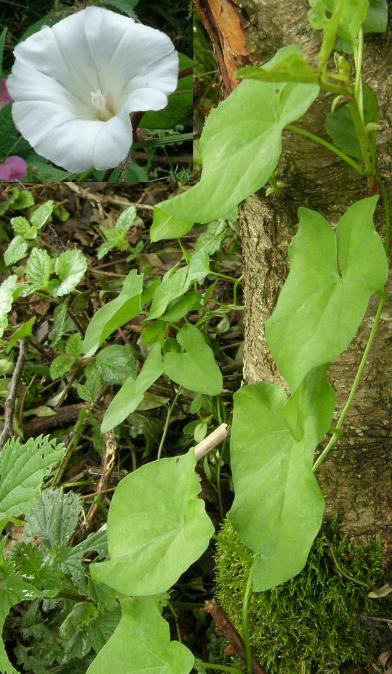Hedge BindweedScientific Names :Calystegia sepium syn. Convolvulus sepium |
Climbing herbaceous perennial, spreading by creeping underground stems which like to congregate near to retaining walls if present, and sometimes by seed. It is very invasive and will smother more delicate ornamental plants if allowed. An extract of the sap acts as a laxative, but is not recommended due to an unpredictable result! (Jalap Bindweed and Scammony Bindweed used officially)
Flowers from June to September, rather attractive, large white trumpets without any scent.
Height - up to 3 m, by entwining itself around anything nearby.
To remove bindweed, first consider where it is growing - cultural control is difficult if it is among other plants. Dig up as much of the white roots as possible, though this can be difficult if they are entangled in the roots of plants as the smallest remnant will
re-grow. (Full details of dealing with roots is given on theWeed Removal page). Hoeing repeatedly will exhaust the white fleshy underground
stems and should weaken it. If it is growing near to a boundary, it will most likely be on both sides so it will have to be removed on the other side as well. A barrier of thick plastic buried to about 40 cm should prevent ingress of the
creeping stems, but it can still scramble through a fence or hedge.
If it is growing through plants it is difficult to remove without damaging the foliage of the host - unless you are very patient enough to unwind every stem. Instead go to ground level and sever all of the bindweed stems. It will wilt within a few hours then die away completely, leaving the host unharmed. Continue to remove any emerging stems or treat them as below.
Never add the uprooted material to the compost heap, unless it has been allowed to dry out completely. Better to put it in the municipal recycling bin where it will be composted at high temperature.
Weedkillers : - A systemic herbicide like Glyphosate is the best option. When it's growing through other plants untangle as much as possible, lay on a plastic sheet or drape it over some pea sticks before treating. After digging up as much as possible, train any regrowth up a cane to allow enough leaf area to develop for treatment. Crushing can help the uptake of the herbicide. One method of application is to use a sponge or a wollen glove placed over a rubber one to soak up the herbicide then clutch the plant as it grows up the support.
Similar, but less rampant, reaching 90 cm, is Field Bindweed (Convolvulus arvensis). See also Bittersweet which has similar twining stems
Nicholas Culpepper
(17th century astrologer-physician)
" This is the plant which
produces Scammony, the gum resin used as a purgative. It does not grow as large in England as abroad.
The juice of the root is hardened and is the Scammony of the shops. The best Scammony is black,
resinous and shining when in the lump, but of a whitish ash-colour when powdered. It has a strong
smell, but not a very hot taste, turning milky when touched by the tongue.
The smallness of the
English root prevents the juice being collected as the foreign; but an extract made from the expressed
juice of the roots has the same purgative quality, only to a lesser degree."
